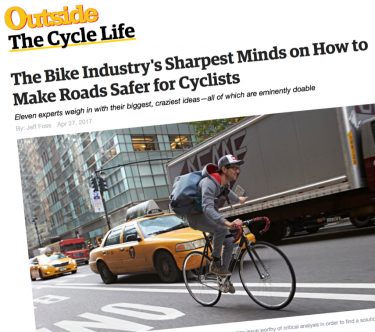Outside Magazine isn’t usually the place we turn to for the latest perspectives on transportation reform. But an article they published online last week, The bike industry’s sharpest minds on how to make roads safer for cyclists, is worth your attention.
And I don’t say just because it features a bit of a rant by yours truly.
Reporter Jeff Foss asked 11 people for their insights on how to make roads in America nicer to cycle on. I decided to share some of my thoughts about cars and car culture. Below is my blurb, followed by a brief outline of what the other 10 folks said:
The United States has fallen way behind in cycling and traffic safety because we don’t do enough to curtail and regulate automobile use. The auto lobby is kicking our butts, and too many of us don’t seem to mind. Far too often, we settle for incremental progress—a new bike lane here, a new bike law there—when what’s needed are big, bold changes in both culture and infrastructure.
Socially, we need to start calling out dangerous driving and our addiction to cars for what it is: deviant and extreme behavior. Driving drunk, driving over the speed limit, hit-and-run, distracted driving—these behaviors have been practically normalized in our culture. The results are streets where people drive amok, and everyone not inside a motor vehicle pays the price.
To make urban cycling great again, we need to address the enemy head-on. Car abuse and overuse must be stopped. We need stronger car control laws. We need elected officials who aren’t afraid to reallocate road space to more efficient, healthy, and safe uses like cycling, mass transit, and walking.
I’ve tried to put those words into action in my daily writings and conversations. What do you think? Do you agree that we need to use a tougher tone when talking about our unhealthy relationship with cars?
Below are brief excerpts from the other responses.
Leah Flickinger, editor of Bicycling magazine:
Every one of us needs to start making noise. For starters, you should contact your elected officials… open your wallet and donate money to support bike advocacy.”
Kristin Armstrong Savola, three-time Olympic time trial gold medalist:
“I personally believe that every city should have colored, separated bike lanes, just like they do in Holland. But I am a realist, and this is just not reality here in the United States… The best path forward is progressively moving from stage to stage and taking incremental steps to make the roads safer for everyone.”
Jillian Harris, senior transportation planner for the City of San Antonio:
“There’s a lot to be said for empathy… Policymakers should ride bikes around their districts to understand what their constituents experience and what could be done to make bike networks better for everyone.”
Advertisement
Colin Strickland, professional road and cyclocross racer:
“Many urban areas have a wealth of underutilized rail, utility, and drainage easements that could be developed into safe and efficient cycling infrastructure… Existing easements help remove cars from the equation while keeping cyclists moving in an efficient linear direction.”
Brian Wiedenmeier, executive director of the San Francisco Bicycle Coalition
“Pilot projects can help us learn about how treatments are applied, and we should solicit feedback from people walking, driving, and biking in and around new infrastructure.”
Rachel Bronson, bicycle planner for Denver County:
“… adjusting traffic signal times at several intersections and installing special equipment to accommodate people on bikes and people in cars separately. At certain intersections, we have bike traffic lights that light up at a different time than for cars… These treatments are smaller in cost and less visible to the casual observer, but they have a big impact to bicycle mobility and safety on our streets.”
Ryan Schutz, executive director of Bikes Together:
“I think we can make biking on city streets safer by requiring everyone to ride bikes to the ice cream shop at least once a week during the summer. I’m serious… This weekly ride would help people understand just how easy it is to hop on a bike and ride somewhere familiar.”
Tim Blumenthal, president of PeopleForBikes.org:
“The United States should adapt the time-tested Dutch practice of providing mandatory bike education to children—once in elementary school and once in middle school.”
Austin Horse, bike messenger, courier-style racer, Red Bull athlete:
“… We should do everything we can to get big rigs away from urban areas… In the future, I think we will see pedestrian-friendly, lightweight, highly mobile cargo delivery services provided by e-trikes and existing cargo bikes. But until then, we need laws to make these rolling tanks unwelcome in places with high concentrations of cyclists.”
Eben Weiss, editor of Bike Snob NYC, author, cycling culture critic:
“What needs to happen now is for road safety to enter the 21st century. It seems like every time I want to stream Game of Thrones on HBO GO, I’m asked to enter an activation code to prove I’m a subscriber. It’s like I’m launching a nuclear missile. Yet if I want to fire up my car—not quite a nuke but certainly a deadly weapon—I don’t have to prove a thing… Then there’s my phone. When I hop in the car, it guesses where I’m going and pings me with directions, ETA, and even traffic-avoidance advice. Yet it’s more than happy to play dumb and let me call, text, or FaceTime even if I’m doing 90 miles per hour on the interstate. Phones should disable these features when drivers are operating their cars—or at the very least remind them to slow down when they’re breaking the law.”
— Jonathan Maus: (503) 706-8804, @jonathan_maus on Twitter and jonathan@bikeportland.org
BikePortland is supported by the community (that means you!). Please become a subscriber or make a donation today.


